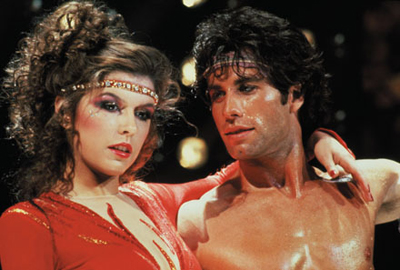Chapter Two
Staying Alive
By Brett Ballard-Beach
July 21, 2011
To those who think the Rocky/Rambo comparison might be inflated, go to IMDb and check out the thumbnails of the original poster art/video box covers (particularly 1 and 5 in the set of 16). Does Travolta not look precisely like Rambo with that feathered hair, sweaty intensity, the suggestion of muscles, and that ridiculous headband? They even over-pronounce the scratch he receives from Jackie to suggest the threat of bodily harm.
This may be one of my favorite movie art images of all time because it promises everything - sex, violence, longing, obsession, and action all lit from within by golden klieg lights - and it’s because it promises so much that I may have held off seeing the film for nearly 30 years. No film, great or so bad it’s great, could deliver on all that. And this one can’t. Staying Alive should at least work as camp, but it never quite carries itself over the edge to where I can laugh and smile and feel a sense of exhilaration and enjoyment at the wrongness of it all. The train wreck spectacle of the finale is visceral, but I feel more embarrassed for all involved than anything.
In a way, the mirror image of Staying Alive in Travolta’s filmography is Battlefield Earth. Both are testaments to the power of box office success to get almost any questionable project made. And in true STAR fashion, Travolta has managed to shrug them off, along with many others, in nearly 40 years in the business. His own natural charisma, evident in Saturday Night Fever, Pulp Fiction, Look Who’s Talking, even a bleak thriller like Blow Out, is missing in Staying Alive. It’s been replaced with a lot of sweat and a lot of self-importance.
Final Thought #1: As well as Staying Alive did, Paramount may have unexpectedly shot themselves in the foot by releasing it so close to the studio’s own Flashdance (That opened in April, three months ahead, and it was still going strong come summer). With a fairly similar story told in an even flashier music-video style, it proved to be the reigning MTV-inspired musical and sleeper of the year, starting out with $4 million its opening weekend and finishing with $94 million by year’s end, not too far behind what Best Picture winner Terms of Endearment would make. (Cynthia Rhodes has a small supporting role as punkish dancer Tina Tech.)
Final Thought #2: The soundtrack to Saturday Night Fever sold 15 million copies, spent 24 weeks at the top of the Billboard Album charts, launched The Bee Gees into a delirious commercial heyday with three straight number one songs - a feat they then matched with their next studio album - and stands as the unofficial musical representation of the disco era. The soundtrack to Staying Alive peaked at #6, spent six months on the charts, sold a million copies, and placed exactly one song in the top ten: the rock song “Far From Over” sung by the director’s brother, Frank Stallone. The Bee Gees have half a dozen songs on the Staying Alive soundtrack and Frank Stallone sings, co-sings (with Rhodes) and/or co-wrote the rest of the songs.
This musical dichotomy, between what was (for the new Bee Gees tunes are pop and ballads but in no way call to mind Saturday Night Fever) and what “is” (the slick, anonymous MOR format that arose in the ‘80s) may be the invisible tug-of-war at the heart of Staying Alive. The disco milieu can in no way be explicitly referenced. (Tony’s mother may show up for two scenes but plans to feature his father, kid sister, and even ex-lover in small supporting roles were either scrapped or shot but not used.) The phenomenon of the first film must be both remembered and forgotten, for disco is the white-suited elephant in the room, the shameful secret that cannot be asked or told.
Saturday Night Fever’s Tony Moreno was a prick in touch with his feelings, who could move with abandon on the dance floor on a weekend night with no fear of reprisal. Staying Alive’s Tony Moreno is a prick with no past, looking out for himself. When he finally grabs the glory and the accolades, there is no use left for him in the story. In an eerie move, Stallone freeze frames him mid-jump in the heart of Times Square and then ghosts him out. All that’s left behind are the glittering lights and broken hearts.
Epilogue: Nik Cohn admitted in 1996 that he made up his magazine article on the New York disco scene, basing it all on working-class disaffected Mods that he had known back in Britain in the 1960s.
Next time: You want The Quickening? You got The Quickening.
Continued:
1
2
3
|
|
|
|




